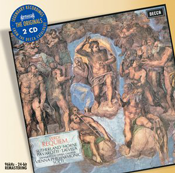It is a logical pairing that brings together two works that fit well together in representing Verdi’s major efforts in sacred music.
Originally recorded in the Sofiensaal, Vienna, Solti’s recording of the Requiem is a durable performance that serves as a touchstone for modern Verdi performances. The performing forces represent the finest of the day, with Requiem involving the Chorus of the Vienna Staatsoper, the Vienna Philharmonic, and soloists who would command the international opera scene for the decades that followed: Dame Joan Sutherland, Marilyn Horne, two women who had just begun to work together in reestablishing bel canto opera; Luciano Pavarotti, the tenor who would become a household name for fine singing worldwide; and Martti Talvela, the Finnish bass who had worked with Sir Georg Solti in recording the monumental Ring cycle for Decca. Solti himself would lead the Chicago Symphony in taking its reputation into international circles. These are remarkable forces to approach any work, and they are all the more impressive for creating one of the finest recordings of Verdi’s Requiem.
Solti’s interpretation of Verdi’s Requiem remains an essential accomplishment of his recording career. In approaching one of the best-known choral works of the nineteenth century, Solti introduced the precision that was part of his genius. In addition, his sense of drama made the famous “Dies irae” section into an awe-inspiring tableau not just through the volume of the forces involved, but in the timing that allowed Verdi’s syncopations to jolt the listener. Not only could he create such grand effects, Solti could establish the sense of intimate, almost chamber-music effect, that other parts of the Requiem demand, as in the “Lacrimosa.” In this piece, the mezzo accompanies the tenor in some passages, and Solti allows the women of the chorus to support the mezzo later in the movement and achieve a similar delicacy. When the full chorus enters, the result is impressively moving for its balance. The diction is always clear, with articulations appropriately unified, and this is evident in the opening of the “Libera me,” one of the defining sections of this outstanding work that brings an almost operatic idiom to the religious text. The close miking of Sutherland in this piece stands in contrasts to the somewhat distant reprise of the “Dies irae,” a distinction that sets a studio performance like this one from a live concert. More importantly, details like these are readily accessible in the remastering of this performance. Improvements are subtle and support the overall effect, which has always been impressive. In some ways this CD release allows the character of the solo voices to emerge clearly. Thus Marilyn Horne’s vibrant voice has a sense of immediacy, like the resonance that distinguishes Martti Talvela’s rendering of the bass parts in this work. Moreover, those familiar with the later recordings of Luciano Pavarotti should appreciate the tenor’s exceptional performance in this relatively early release, which stands as testimony of his unique talent.
In addition to this exceptional reading of Verdi’s Requiem, this release includes Solti’s performance of the Quattro Pezzi Sacri that was he recorded approximately a decade later. Albeit with different forces than he used with the Requiem, the Chicago Symphony Chorus and Orchestra are equally impressive in this release. In assembling these pieces from the latter part of his career, Verdi combined three Marian prayers, “Ave Maria,” “Stabat Mater,” and “Laudi alla Vergine Maria,” along with the ancient Ambrosian hymn “Te Deum.” A text that is associated with the liturgy of the hours, Verdi’s setting of the “Te Deum” stands alongside those of such composers as Haydn, Mozart, Berlioz, Dvořák, and Bruckner. In Solti’s hands, the dramatic power of Verdi’s setting is apparent, yet always fitting into the structure of the music. This is similar to the way in which Solti treated the “Stabat Mater,” a challenging piece in itself because of the variety of textures and timbres, as well as the expressive demands. Verdi’s Te Deum is even more demanding, and Solti’s efforts are admirable. Dramatic and intense, it remains impressive, and those who have not heard it recently will find easy access to the performance in this appropriately entitled “Legendary Recording” rerelease of Verdi’s Requiem.
James L. Zychowicz
